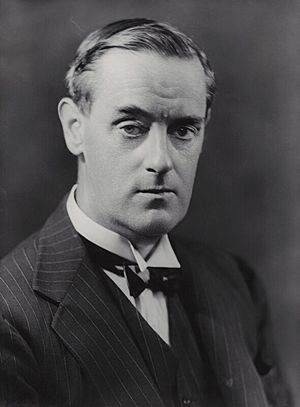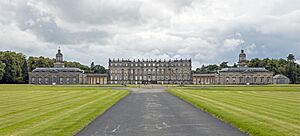Victor Hope, 2nd Marquess of Linlithgow facts for kids
Quick facts for kids
The Most Honourable
The Marquess of Linlithgow
|
|
|---|---|
 |
|
| Viceroy and Governor-General of India | |
| In office 18 April 1936 – 1 October 1943 |
|
| Monarch | Edward VIII George VI |
| Prime Minister | Stanley Baldwin Neville Chamberlain Winston Churchill |
| Preceded by | The Marquess of Willingdon |
| Succeeded by | The Viscount Wavell |
| Personal details | |
| Born | 24 September 1887 South Queensferry, Linlithgowshire, Scotland |
| Died | 5 January 1952 (aged 64) South Queensferry, Linlithgowshire, Scotland |
| Spouse |
Doreen Milner
(m. 1911) |
| Children |
|
| Parents |
|
| Alma mater | Ludgrove School and Eton College |
| Occupation | Politician, agriculturalist, colonial administrator |
Victor Alexander John Hope, 2nd Marquess of Linlithgow (born September 24, 1887 – died January 5, 1952) was an important British politician. He was also an expert in farming and a colonial administrator. He is best known for serving as the Viceroy and Governor-General of India from 1936 to 1943. People often called him simply Linlithgow.
He also held other important positions. He was the vice president of the Royal Society of Edinburgh. He was also the Chancellor of the University of Edinburgh and the Lord High Commissioner to the General Assembly of the Church of Scotland.
Contents
Early Life and Family Background
Victor Hope was born on September 24, 1887. His birthplace was Hopetoun House in South Queensferry, Scotland.
He was the oldest son of John Adrian Louis Hope, who was the 1st Marquess of Linlithgow. His mother was Hersey Everleigh-de-Moleyns. A very special person was his godmother: Queen Victoria.
Victor went to Ludgrove School and Eton College for his education. When he was 20 years old, on February 29, 1908, he became the 2nd Marquess of Linlithgow after his father passed away.
In 1912, at just 25 years old, he became a Fellow of the Royal Society of Edinburgh. He later served as the society's vice president from 1934 to 1937.
Early Career and Public Service
Linlithgow served as an officer during the First World War. He fought on the Western Front. He commanded a group of soldiers called a battalion of the Royal Scots. He was recognized for his bravery and became an Officer of the Order of the British Empire. He finished the war as a colonel.
After the war, he worked in various smaller roles in the British government. From 1922 to 1924, he worked for the British Admiralty, which manages the navy. He also led the Unionist Party Organisation for two years starting in 1924.
He was also the president of the Navy League from 1924 to 1931. Linlithgow also chaired the Medical Research Council. He led the governing body of the Imperial College London. He was also involved in farming, leading a committee on how farm products were sold and priced.
In 1926, he led a special group called the Royal Commission on Agriculture in India. This group studied farming in India and shared its findings in 1928. Because of this work, when he became Viceroy of India later, he was very interested in improving nutrition there.
From 1933 to 1934, he led a special committee in Parliament. This committee looked at plans for India to govern itself more. The ideas from this committee became the Government of India Act 1935. This law was a big step towards India gaining more control over its own affairs.
Viceroy of India
Linlithgow had turned down other important jobs before. He was offered to be the governor of Madras and the governor-general of Australia. But he accepted the role of Viceroy of India. He took over from Lord Willingdon. He arrived in Bombay, India, with his family on April 17, 1936.
As Viceroy, Linlithgow put into action the plans for local self-government. These plans were part of the Government of India Act 1935. This led to local governments being formed in many parts of British India. However, some local leaders, called princes, did not want elected governments in their areas.
When the Second World War started in 1939, Linlithgow declared that India was at war with Germany. He did this without asking Indian politicians first. This made many Indian leaders unhappy. The Congress Party asked for a promise that India would be able to decide its own future after the war. When Linlithgow refused, the Congress Party leaders resigned from their government roles.
On August 8, 1940, Linlithgow made a statement known as the August Offer. This offer gave Indian people more rights in governing India. However, most Indian politicians, including the Congress Party and the Muslim League, did not accept it.
Disagreements between the British government and the Congress Party continued. This led to a large protest movement in India called the Quit India Movement. Linlithgow stopped these protests and arrested the Congress leaders. Some historians believe Linlithgow was partly responsible for the Bengal famine of 1943. This terrible event led to the deaths of three million people.
Later Life and Legacy
Linlithgow's time as Viceroy lasted seven years. This was the longest time anyone had held that position in the history of the British Raj. His term ended in 1943.
Many people in India had mixed feelings about his time as Viceroy. V. P. Menon, a historian, wrote that Linlithgow's time "was noticeable for its lack of positive achievement." He also noted that when Linlithgow left India, there was a famine and economic problems. Tej Bahadur Sapru, an Indian politician, said that India was "much more divided" when Linlithgow left than when he arrived.
Linlithgow was a sincere Presbyterian, a type of Christian. He served as Lord High Commissioner to the Church of Scotland in 1944 and 1945. He passed away in 1952.
Honours and Titles
Victor Hope held many important titles and received several honours throughout his life. These titles changed as he gained more recognition.
- 1887–1902: Victor Alexander John Hope, Viscount Aithrie
- 1902–1908: Victor Alexander John Hope, Earl of Hopetoun
- 1908–1917: The Most Honourable The Marquess of Linlithgow
- 1917–1919: The Most Honourable The Marquess of Linlithgow, TD
- 1919–1928: The Most Honourable The Marquess of Linlithgow, OBE, TD
- 1928–1929: The Most Honourable The Marquess of Linlithgow, KT, OBE, TD
- 1929–1935: The Most Honourable The Marquess of Linlithgow, KT, GCIE, OBE, TD
- 1935–1936: The Most Honourable The Marquess of Linlithgow, KT, GCIE, OBE, TD, PC
- 1936–1943: His Excellency The Most Honourable The Marquess of Linlithgow, Viceroy and Governor-General of India, KT, GCSI, GCIE, OBE, TD, PC
- 1943–1952: The Most Honourable The Marquess of Linlithgow, KG, KT, GCSI, GCIE, OBE, TD, PC
- in Scotland: May 1944, May 1945: His Grace The Lord High Commissioner
He received several prestigious awards:
 United Kingdom:
United Kingdom:
 Knight of the Most Noble Order of the Garter (KG)
Knight of the Most Noble Order of the Garter (KG) Knight Companion of the Most Ancient and Most Noble Order of the Thistle (KT)
Knight Companion of the Most Ancient and Most Noble Order of the Thistle (KT) Knight Grand Commander of the Most Exalted Order of the Star of India (GCSI)
Knight Grand Commander of the Most Exalted Order of the Star of India (GCSI) Knight Grand Commander of the Most Eminent Order of the Indian Empire (GCIE)
Knight Grand Commander of the Most Eminent Order of the Indian Empire (GCIE) Officer of the Most Excellent Order of the British Empire (OBE)
Officer of the Most Excellent Order of the British Empire (OBE) Recipient of the Territorial Decoration (TD)
Recipient of the Territorial Decoration (TD)
Family Life
On April 19, 1911, Victor Hope married Doreen Maud Milner. She was the younger daughter of Sir Frederick Milner. Victor and Doreen had five children together: twin sons and three daughters.
Their children were:
- Charles William Frederick Hope, 3rd Marquess of Linlithgow (born April 7, 1912 – died 1987). He inherited his father's title.
- John Adrian Louis Hope, 1st Baron Glendevon (born April 7, 1912 – died January 18, 1996). He also became a Conservative politician.
- Lady Anne Adeline (born January 27, 1914 – died 2007).
- Lady Joan Isabella (born September 21, 1915 – died 1989).
- Lady Doreen Hersey Winifred (born June 17, 1920 – died January 22, 1997). She was the mother of Lucinda Green, a famous horse rider.



